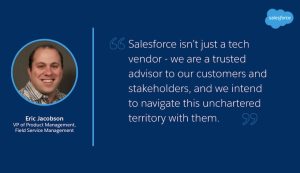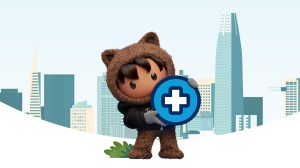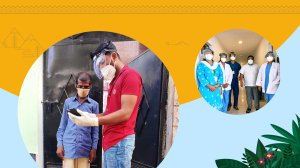Salesforce is committed to providing tools to help organizations respond and recover from the challenges of COVID-19. We recently released Work.com, a suite of solutions and resources to enable business and community leaders reopen safely, while helping to keep employees, customers and partners safe and informed during the COVID-19 pandemic and beyond.
In this series, we’ll dive deeper into each of the Work.com capabilities: why we built them, how we built them, and how customers can leverage them in their response to COVID-19. This week, we’ll focus on the Shift Management solution in work.com, which helps businesses coordinate the return of employees to the office with capabilities to schedule workers in shifts and help reduce office density.
To learn more about Shift Management and how the Salesforce team quickly brought this solution to life, we talked with Eric Jacobson, VP Product Management at Salesforce. Read on for the full interview.
Q. What do you do at Salesforce?
I lead the Field Service Management product group, which is focused on bringing service solutions to mobile workforces. When I joined Salesforce, I initially worked with the Platform team for five years then, a little over a year ago, I transitioned to Field Service Lightning, which is one of the fastest growing applications in Salesforce history.
Q. What are some of the challenges that organizations face in their response to COVID-19?
It’s been a progression. At first it was, how do we adapt to the fact that we’re all working remotely? And then, how do we embrace it?
Having the right tools in place makes a difference. The more collaborative a company can be, the better. I see this personally from the standpoint of working with a globally distributed team. I work with people across 10-hour time differences so remote work isn’t new, but given that it’s become the new norm we’re all now finding ways to become better at working with a remote-first culture.
Q. Knowing those challenges, how did Shift Management come to be a solution?
As businesses take steps towards recovery, we started to think about how we could safely come back to the workplace. This is truly an unprecedented problem. Nobody in our lifetime has thought about the implications of closing all the offices around the globe then reopen them, bring people in, and ensure we don’t create a second phase of the pandemic.
We looked at this as a chance to solve a truly unique problem that has never existed before. Of course, people have already thought about how to do staffing, especially in retail, restaurants or hotels. But how do you get employees to come back to a large office setting? It’s just not a problem that the world had contemplated, especially in dense, urban, high-rise office settings.
There are a whole new set of conditions to think about, including how to stagger the arrival times of employees to ensure lobbies and elevators don’t become overcrowded, and how to appropriately social distance once in the office – at your desk, in common areas such as bathrooms and kitchens. This was the impetus behind building the Shift Management solution in work.com.
Q. How can a business leverage Shift Management?
Companies everywhere are thinking through how they will reopen their offices, but they know they’re not going to bring everybody back immediately, depending on local, regional, and national requirements. That means that an office that was designed to hold 1,000 people might only be able to reopen with 100 people to begin with.
So companies can use our Shift Management tools to calculate availability for reopening at a certain scale, and analyze the challenges at the floor level, or even specific areas within that floor. Companies can use our tools to figure out when people are available, what allocations of available space there might be, and much more.
Q. Where do you see the most potential for Shift Management to add value to organizations?
Shift Management is most useful in handling business interruptions – COVID-19 or otherwise. Given that it tackles scheduling based on allowed workspace capacity, employers and HR departments can simply set the parameters based on what is deemed safe then the Shift Management solution removes the guesswork – helping organizations get back to work safely.
Q. What was the actual development process like?
Thankfully, we didn’t have to start from scratch. Shift Management is based on our field service management portfolio of products, a set of tools for managing a mobile workforce on one platform to deliver intelligent, in-person service. As part of that we have one of the world’s best scheduling engines.
And so we asked ourselves, how do we take a product that was created to send a technician out to service a machine or deliver a product, and then rework that to apply it to several employees slated to come back to their offices – effectively going from a customer-centric to employee-centric use case? We looked at the data model and looked at the way the product was designed, and essentially mapped the new problem to this functionality. What we’ve produced is a way to automate much of the decision-making in managing shifts and getting people back to work safely in a data-driven way.
Q. You mentioned Shift Management was built on top of Field Service Lightning. Can you talk a bit about that, and can you give us a few examples of companies using Field Service Lightning to tackle COVID-19?
Field Service Lightning takes a customer-facing stance. It’s about scheduling technicians or employees or mobile workers to go to a customer site, whether it’s a place of business or a home to do a job. Shift Management, though, is about scheduling employees to come to their employer’s workplace. So these tools have similar but different approaches to scheduling.
We’ve seen a number of things happening in the field service space as a result of COVID-19, and I think certain trends are going to stick with us. For example, there is increased use of technology for remote support, and there is more use of remote training. We’re seeing this with industrial safety company Fike Corporation, for example. Using Field Service Lightning and Salesforce partner SightCall, Fike is remotely training field technicians, increasing the size and scale of their technician workforce, improving service results, and keeping both employees and customers safer.
Healthcare providers are also using our tools to video chat instead of taking in-person consultations. Community Vision is a non-profit, community-based organization that has increased the safety and well-being of its clients who are vulnerable to COVID-19. They are using Field Service Lightning to conduct virtual medication prompts and ensure they continue to take their medicines at the right times.
In cases where in-person service is still going on, companies are thinking about how to do that safely. With Field Service Lightning, you can arrange pre-arrival checklists for people to run through, and these can help key tasks happen in proper order. This is something Snap Install, Inc. has implemented for its technicians, as well as incorporating the checklist directly into its mobile app. This allows Snap to proactively recognize exposure risks and protect customers.
We continue to work on tools that optimize the experience whether or not a technician is physically coming to do work. As another example, property valuation and advisory firm WBP Group needed to reshape how it operated and minimize contact between employees and customers in response to COVID-19. They launched a property Virtual Valuations solution through Salesforce Sales Cloud, Service Cloud, and Community Cloud. They are also leveraging Field Service Lightning to increase the efficiency of scheduling appointments, which will be used to manage valuations from end-to-end and to ensure the delivery of a great experience to the customer – even if they’re not coming in.
Q. Where does your team go from here?
I think we will all learn a lot as the world comes back to work. We’re in a leading position in terms of helping bring people back to work, and it has been an energizing experience to rally teams from across the globe to make returning to work happen. We intend to adapt the product as organizations’ needs change, which they will. And we have learned that there will be an evolution to how we move forward. But I believe the end result will be that we bring people safely back to the workplace – and I look forward to being able to collaborate in person again with my team.





















